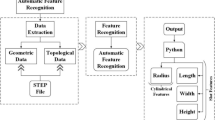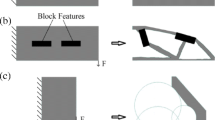Abstract
Research on computer integrated design and manufacture based on feature extraction (FE) so far has been largely focused on finding all or some possible features, and the task of manufacturing analysis is shifted to process planners. In this paper an attempt has been made to propose a system of FE for 3D components to automate planning activities in a computer integrated manufacturing environment. The FE identifies machining features in a generic manner, while feature reasoning gives the information required for manufacturing, taking 3D model data in standard for exchange of product data format as input to the FE system. To further support the development of generic FE algorithms it is proposed that neutral files be used as a common starting to eliminate problems associated with applying FE techniques to legacy CAD models. Neutral files can remove the effects of modelling practice and specific aspects of CAD software that can change the hierarchical history of the part without altering the geometry.









Similar content being viewed by others
References
M.P. Bhandarkar, R. Nagi, STEP-based feature extraction from STEP geometry for agile manufacturing. Comput. Ind. 41, 3–24 (2000)
J.H. Han, M. Kang, H. Choi, STEP-based feature recognition for manufacturing cost optimization. Comput. Aided Des. 33, 671–686 (2001)
S. Owusu-Ofori, Part design using manufacturing features. J. Intell. Manuf. 5, 55–63 (1994)
Bor-Tyng Sheen, Chun-Fong You, Machining feature recognition and tool-path generation for 3-axis CNC milling. Comput. Aided Des. 38, 553–562 (2006)
B.M. Smith, IGES: a key to CAD/CAM systems integration, National Bureau of Standards. Comput. Gr. Appl. IEEE 3(8), 78–83, ISSN: 0272-1716, doi: 10.1109/MCG.1983.263328
A. Kumar, J. Saha, Automatic data extraction from ISO10303-21 (STEP) for feature recognition. ARISER 4(3), 129–136 (2008)
STEP Application Handbook ISO 10303, Version 3, 30 June 2006, SCRA, 5300 International Boulevard, North Charleston, SC 29418
ISO 10303 (1994) Standard for the Exchange of Product model data (STEP)
ISO 10303-224 (1999) Industrial automation systems and integration. Product data representation andexchange—Part 224. Application protocol: mechanical product definition for process planning using machining features
R. Sharma, J.X. Gao, A progressive design and manufacturing evaluation system incorporating STEP AP224. Comput. Ind. 47, 155–167 (2002)
L. David, Fundamentals of STEP Implementation STEP Tools Inc, Troy, (1999)
X.G. Ming, K.L. Mak, J.Q. Yan, A PDES/STEP-based information model for computer-aided process planning. Robot Comput. Integr. Des. 14, 347–361 (1998)
S.M. Amaitik, Towards STEP based CAD/CAPP/CAM Systems, 6th International DAAAM Conference INDUSTRIAL ENGINEERING (Tallinn, Estonia, 2008), pp. 24–26
H. Kahn, N. Filer, A. Williams, N. Whitaker, A generic framework for transforming EXPRESS information models. Comput. Aided Des. 33, 501–510 (2001)
J. Gao, D.T. Zheng, N. Gindy, Extraction of machining features for CAD/CAM integration. Int. J. Adv. Manuf. Technol. 24, 573–581 (2004)
V.Cicirello, W. C.Regli, Machining feature-based comparisons of mechanical parts, SMI-2001: International Conference on Shape Modeling and Applications, Geneva, Italy (2001)
W.C. Regli, S.K. Gupta, D.S. Nau, Extracting alternative machining features: an algorithmic approach. Res. Eng. Des. 7(3), 173–192 (1995)
M.J. Pratt, B.D. Anderson, T. Ranger, Towards the standardized exchange of parameterized feature-based CAD models. Comput. Aided Des. 37, 1251–1265 (2005)
K. Case, M. Hounsell, Feature modeling: a validation methodology and its evaluation. J Mater. Process. Technol. 107, 15–23 (2000)
J. Cherng, X. Shao, Y. Chen, P. Sferro, Feature-based part modeling and process planning for rapid response manufacturing. Comput. Ind. Eng. 34(2), 515–530 (1998)
M. Kang, J. Han, J.G. Moon, An approach for interlinking design and process planning. J. Mater. Process. Technol. 139, 589–595 (2003)
B. Khoshnevis, D. Sormaz, J.Y. Park, An integrated process planning system using feature reasoning and space search-based optimization. IIE Trans. 31, 597–616 (1999)
M. Mantyla, D. Nau, J. Shah, Challenges in feature-based manufacturing research. Commun. ACM 39(2), 77–85 (1996)
H. Miao, N. Sridharan, J.J. Shah, CAD–CAM integration using machining features. Int. J. Comput. Integr. Manuf. 15(4), 296–318 (2002)
J.J. Shah, P. Sreevalsan, A. Mathew, Survey of CAD/feature-based process planning and NC Programming techniques. Comput.-Aided Eng. J. 8, 25–33 (1991)
S. Joshi, T.C. Chang, Graph based heuristics for recognition of machined features from a 3-D solid model. Comput. Aided Des. 20, 58–66 (1988)
S. Gao, J.J. Shah, Automatic recognition of interacting machining features based on minimal condition subgraph. Comput. Aided Des. 30(9), 727–739 (1998)
P.D. Stefano, F. Bianconi, L.D. Angelo, An approach for feature semantics recognition in geometric models. Comput. Aided Des. 36, 993–1009 (2004)
J.H. Vandenbrande, A.A.G. Requicha, Spatial reasoning for the automatic recognition of machinable features in solid models. IEEE Trans. Pattern Anal. Mach. Intell. 15, 1–17 (1993)
W.C. Regli, S.K. Gupta, D.S. Nau, Toward multiprocessor feature recognition. Comput. Aided Des. 29(1), 37–51 (1997)
J. Han, M. Pratt, W.C. Regli, Manufacturing feature recognition from solid models: a status report. IEEE Trans. Robot. Autom. 16(6), 782–796 (2000)
T. Woo, Feature extraction by volume decomposition. In: Proceedings of the conference on. CAD/CAM technology in mechanical engineering (1982), pp. 76–94
Y. Kim, Recognition of form features using convex decomposition. Comput. Aided Des. 24(9), 461–476 (1992)
J. Dong, S. Bijayan, Manufacturing feature determination and extraction—Part 1: optimal volume segment. Comput. Aided Des. 29, 475–484 (1997)
T. Lim, H. Medellin et al., Edge-based identification of DP-features on free-form solids. IEEE Trans. Pattern Anal. Mach. Intell. 27(6), 851–859 (2005)
V. Sundararajan, P.K. Wright, Volumetric feature recognition for machining components with freeform surfaces. Comput. Aided Des. 36, 11–25 (2004)
B. Li, J. Liu, Detail feature recognition and decomposition in solid model. Comput. Aided Des. 34, 405–414 (2002)
N. Joshi, D. Dutta, Feature simplification techniques for freeform surface models. J. Comput. Inf. Sci. Eng. 3(9), 177–186 (2003)
J. Gao, D.T. Zheng, N. Gindy, D. Clark, Extraction/conversion of geometric dimensions and tolerances for machining features. Int. J. Adv. Manuf. Technol. 26, 405–414 (2005)
B.S. Prabhu, S. Biswas, S.S. Pande, Intelligent system for extraction of product data from CADD models. Comput. Ind. 44, 79–95 (2001)
J.J. Shah, Y. Yan, B.C. Zhang, Dimension and tolerance modeling and transformation in feature based design and manufacturing. J. Intell. Manuf. 9, 475–488 (1998)
S.C. Park, Knowledge capturing methodology in process planning. Comput. Aided Des. 35, 1109–1117 (2003)
K.V. Ramana, P.V.M. Rao, Data and knowledge modeling for design-process planning integration of sheet metal components. J. Intell. Manuf. 15, 607–623 (2004)
W.D. Li, S.K. Ong, A.Y.C. Nee, Hybrid genetic algorithm and simulated annealing approach for the optimization of process plans for prismatic parts. Int. J. Prod. Res. 40(8), 1899–1922 (2002)
T.N. Wong, L.C.F. Chan, H.C.W. Lau, Machining process sequencing with fuzzy expert system and genetic Algorithms. Eng. Comput. 19, 191–202 (2003)
S.C. Feng, A machining process planning activity model for systems integration. J. Intell. Manuf. 14, 527–539 (2003)
S.C. Feng, E.Y. Song, A manufacturing process information model for design and process planning integration. J. Manuf. Syst. 22(1), 1–15 (2003)
H. Shin, G.J. Olling, Y.C. Chung et al., An integrated CAPP/CAM system for stamping die pattern machining. Comput. Aided Des. 35, 203–213 (2003)
F. Wang, J.J. Mills, V. Devarajan, A conceptual approach managing design resource. Comput. Ind. 47, 169–183 (2002)
Y. Zhang, C.C. Zhang, H.P.B. Wang, An Internet based STEP data exchange framework for virtual enterprises. Comput. Ind. 41, 51–63 (2000)
X.W. Xu, Q. He, Striving for a total integration of CAD, CAPP, CAM and CNC. Robot. Comput. Integr. Manuf. 20, 101–109 (2004)
ISO 10303-47 Integrated Generic Resources: Shape Tolerance Resource Model, Part 47, ISO (1994)
J. Han, A. Requicha, Integration of feature based design and feature recognition. Comput. Aided Des. 29(5), 393–403 (1997)
Author information
Authors and Affiliations
Corresponding author
Rights and permissions
About this article
Cite this article
Borkar, B.R., Puri, Y.M. Automatic Extraction of Machining Features from Prismatic Parts using STEP for Downstream Applications. J. Inst. Eng. India Ser. C 96, 231–243 (2015). https://doi.org/10.1007/s40032-015-0171-3
Received:
Accepted:
Published:
Issue Date:
DOI: https://doi.org/10.1007/s40032-015-0171-3




